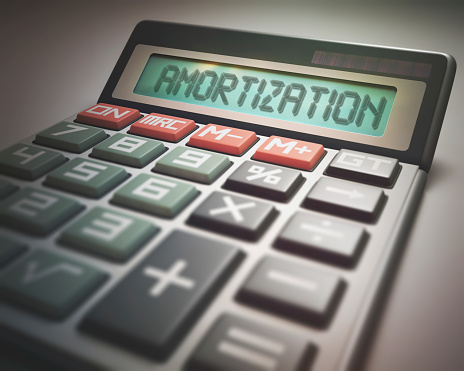What is Amortization?
Amortization is when you take your debt and make a payment schedule, calculating each payment amount until it’s paid off entirely. This is usually in reference to any type of a loan that has added interest.
What is loan amortization?
To “amortize” literally means “to kill it off”, so this term is specifically for those who are paying off their debt in the form of fixed payments. Amortization can be used for large expenses in business, but with the same concept in that it’s done in increments. For example, a business will make a large investment that is expected to bring in a large ROI (return on investment) over several years. Businesses will write off the expense incrementally over years instead of writing off such a large investment purchase all at once. More commonly, amortization is also used for loans such as student loans, home mortgages, auto loans, etc.. With amortization, you are spreading out a loan into a series of fixed payments over time. You will be paying off the loan interest and principal in different amounts each month with your total payment remaining equal each period. The most common form of amortization happens with monthly loan payments, with the most popular being home loans and auto loans. A portion of these loan payments includes interest costs and reducing your loan balance by paying off the loan principal.
Amortization is the process of spreading out a loan into a series of fixed payments over time. You’ll be paying off the loan’s interest and principal in different amounts each month, although your total payment remains equal each period. This most commonly happens with monthly loan payments, but amortization is an accounting term that can apply to other types of balances, such as allocating certain costs over the lifetime of an intangible asset.
With long term loans, interest costs are at their highest with the majority of each periodic payment being an interest expense where you only pay off a small portion of the loan balance. With time, each payment will go more to your principal and you will pay less interest each month. These amortized loans are made to pay off the loan balance over a period of time. A common example is 30 year mortgage.
What is an amortization schedule?
An amortization schedule uses columns and rows to illustrate payments over the life of a loan. The table will allow borrowers to see how their loans are going to be paid back with a breakdown of interest and principal. If you’re looking to see what your monthly payment will be if you borrow a certain amount, there are many resources online that are free, such as amortization calculators that can predict what payments will be each month through inputting information such as loan amount, interest and total payment schedules.
Different mortgage types have different term lengths, but since amortization only applies to fixed interest rate mortgages, it will most likely be 15 or 30 years unless you and the lender decided on a different term. Once you enter all of this information, you can see how much each payment will be. You will also get a breakdown of how much of each payment will go towards the principal and the interest.
You’ll see that for the earlier payments, the majority of your monthly payments are going to interest. When deciding between a 15-year fixed and a 30-year fixed, you’ll see that a shorter term will result in building equity much faster. With a 30-year fixed, the first 12 years’ monthly payments have the majority of the payment amount going to interest.
What are the different types of amortizing loans?
There are many types of loans out there, but here is a breakdown of some of the most popular:
Auto Loans
Typically paid down in five years, these are amortized loans you pay with a fixed monthly payment.
Home Loans
The traditional home loans are 15 and 30 year fixed rate mortgages, however most consumers sell their home or refinance the loan before the loan term is up.
Personal Loans
These loans are usually three year term loans with fixed interest rates and monthly payments, typically for debt consolidation to pay down credit card debt.
How do you calculate amortization?
If you’re going to be paying the same amount every single month until the loan is paid off and the interest rate is fixed, why is there a need for a fancy formula (yes, there’s a formula to calculate each payment)? You could easily get the interest rate, multiply that by the principal, add that amount to the principal and divide it by the amount of payments, right? Wrong.
The reason why that isn’t the case, is because with amortization the interest rate isn’t for the entire loan. The interest rate is actually the monthly rate. When you take the interest rate and divide it by 12 (for the amount of months there are in a year) and multiply it by the principal, the total interest you pay will be more.
With an amortizing loan, you first need to figure out the monthly payment of the loan based on the loan amount, the interest rate and how many years the loan lasts. To amortize this loan, you will need to complete the following steps:
- Begin with your starting loan balance
- Figure out the monthly payment
- Identify the interest charge for each period
- Subtract the interest charge from your payment
- Reduce the loan balance from the principal amount
- Start over with the following month and apply to the new loan balance
What type of loans don’t get amortized?
Interest only loans
These are loans that during the interest only period you will only pay down the principal if you make additional payments over the interest cost.
Balloon Loans
These loans require you to make a large principal payment at the end of the loan. In the beginning of the loan, you make smaller payments, but the entire loan will be due eventually, at the end of the life of the loan with the large principal balance still intact. The only way to satisfy balloon mortgages or other similar credit instruments is to wipe out the full remaining balance with one final payment.
Credit Cards
Credit cards are not amortizing loans, but allow you to borrow repeatedly on the same card and allow you to choose how much you’ll repay each month.
What are the advantages of loan amortization?
Amortization loans spread out principal payments more evenly than other loans that are weighted unevenly, having lump payments toward the end of the financing periods. With these loans, the original purchase price of the asset continues to amortize until fully paid off. This can be much more advantageous than balloon loans, as with an amortizing loans the borrower can keep budgets more manageable and are not caught off guard at the end of the loan where they may be forced into a refinance of the loan to draw out the loan even further.
Bottom Line
Yes, it is ideal that everyone can buy homes in cash and in full, but it isn’t common. Most people don’t have that kind of money lying around. Thankfully, mortgages allow us to purchase homes and pay it off in installments. Paying a lot in interest isn’t ideal, but sometimes having property to call your own is worth it. If it’s something that you can afford, getting a mortgage with a short term would be best because you pay significantly less in interest.



